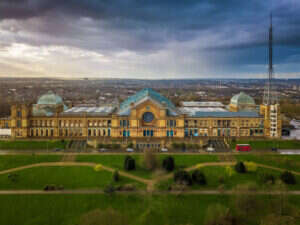The ‘aerotropolis’ has been described by U.S. business consultant John Kasarda, the pioneer of the concept, as the “city of the future”. The notion of building a city around an airport, not the other way round, has been deemed to be crucial for economic development. Just as urban areas sprawled around railroads in the 1800s, and highways in the 1900s, the thinking is that business and commerce will jump at the opportunity to be based near a world-class, international hub.
Amsterdam Schiphol and Seoul Incheon have been widely seen as the two poster children for the concept of the aerotropolis. But are airport cities really that glamorous in reality?
Fast forward eleven hours from Heathrow, and one lands in the stylish Terminal 1 of Seoul Incheon (IATA code: ICN), a routine prize-winner in the “World’s Best Airport’ awards. Every time I have landed there, there is some new addition to the hi-tech gizmos on show in the arrivals lounge, whether high-tech sanitation in the restrooms, a high-speed railway linking Incheon with the rest of Seoul, or, on my recent arrival, automated robots making sure the floors of Arrivals were polished to perfection.
Yet much of the attention has focused not on ICN, but its aerotropolis of Songdo, officially the Songdo International Business District. A ‘smart city’ built from scratch on reclaimed land, Songdo was destined to be the prototype cosmopolitan aerotropolis, the city of the future: home to international university campuses, globe-trotting businessmen, multinational financial firms, as well as a place for high-end tourism. The 2012 Presidents Cup golf tournament was played at the Jack Nicklaus-designed golf course in Songdo. What better way to attract an international clientele?
Yet have a look around Songdo, and it feels like a ghost town. The students are there, businessmen come and go, restaurants and department stores open their doors, yet something is missing.
The lack of footfall and sporadic numbers of ‘cosmopolitan clientele’ were crystal clear as I walked down the deserted streets. Songdo is no exception to South Korea’s obsession with high-rise life, but more apartments are being built than tenants moving in. In what looks like a half-hearted attempt to emulate the epitome of global urban cosmopolitanism, New York, the high-rise apartments encircle a designated park named Central Park.
Central Park. Image: Dongjun Kim/Wikipedia.
Songdo also promised environmental and technological progress. Amongst the city’s many accolades, it has claimed the title of the world’s first ‘smart’ city: sensors have been placed throughout the area to gather information on traffic flows, and apartments are fitted with the latest technological accouterments. The frequent-flying businessman can make video calls from the televisions in the apartments, and the global student can attend university classes remotely. Trash is collected and separated automatically, sucked out of apartments by a vacuum chute, and, within the blink of an eye, arrives at the sorting facility.
These are hallmarks of an efficient city – but only if there are car users for whom tracking pollution levels and traffic flows may be useful, if there are businessmen who actually make use of the LED television screens to conference call, and if there is enough trash to be recycled and sorted, come to that.
Speaking to those who live in Songdo and its vicinity, the hype all seems a bit much. With South Korea increasing in its technological innovation day-by-day, the ability to host a conference call from one’s LED television screen is no big deal. Similar waste collection has been tried tested in Singapore, amongst other cities: again, nothing to get excited about.
And most of all, when I asked where the cosmopolitan citizens are, the reply was simple: “They are all in Seoul, and will stay in Seoul.” Something has clearly gone wrong for Songdo, not least the fact that the city’s construction on reclaimed land has attracted its fair share of criticism from environmental groups – but a big problem is that it has failed to attract the globetrotting, frequent-flying, citizen-of-the-world.
There are plenty of airports around which commerce, retail, and residence are becoming ever more numerous, which raises the question of whether the aerotropolis is actually something new. Just as it is nothing out of the ordinary that businesses sprawled along the railroads in the 19th century, maybe the airport is just the railroad of today: it is only natural for urban life to blossom around it.
Maybe we should pay less attention to the new ‘cities’ springing up around airports, and more on the airports themselves. They may seem like mere waiting rooms to some – but they can be rich sources of architecture, technology, big data, and fascinating places in their own right. Incheon’s Terminal 2 opened in January of this year. It promises to be just as glamorous, efficient, and technologically-embedded, if not more, than Terminal 1.
So next time you see someone checking-in to a flight with an ‘ICN’ tag on their luggage, you may know one thing. They may be flying to Incheon, but chances are they will not set foot in Songdo.







